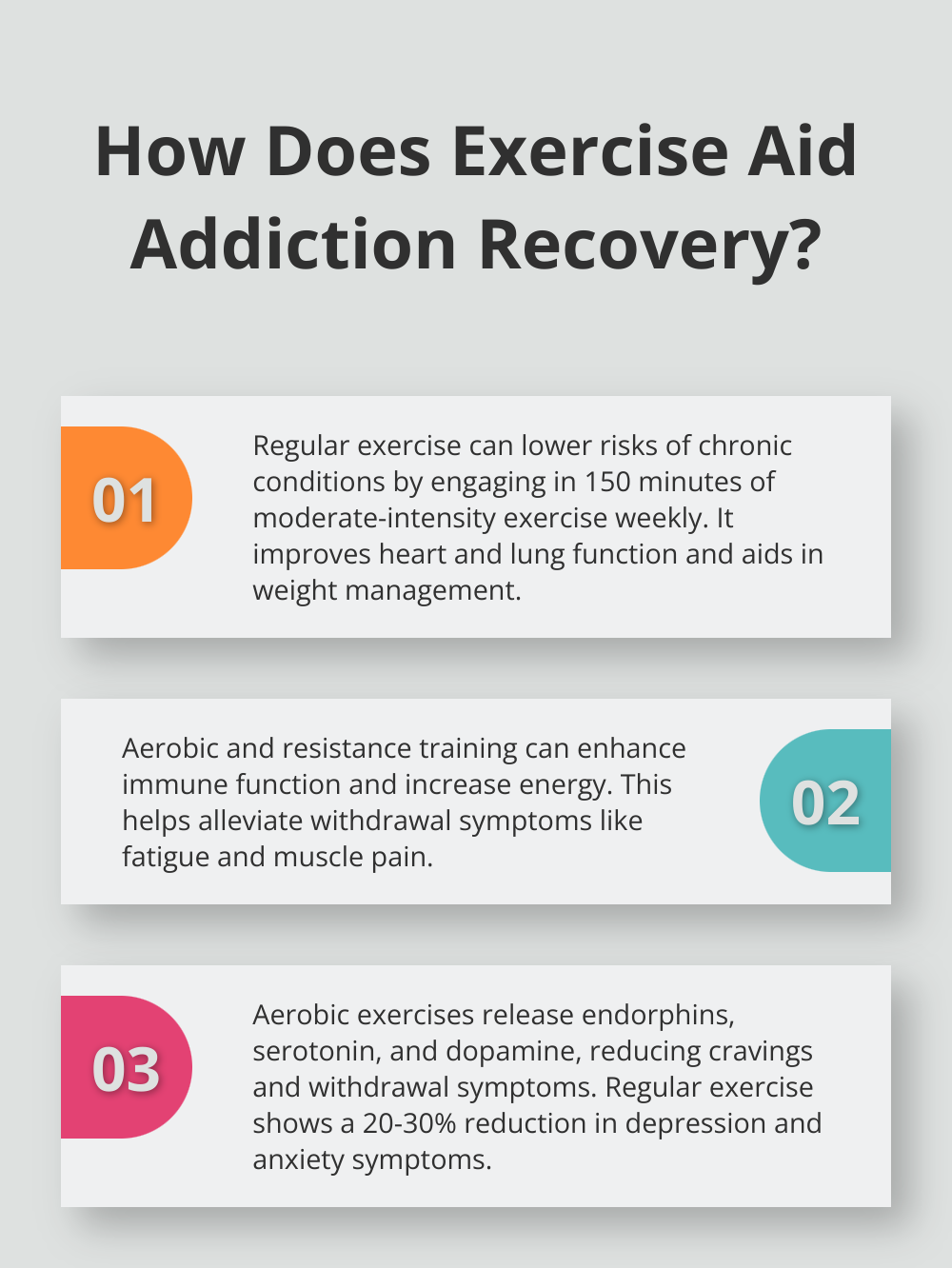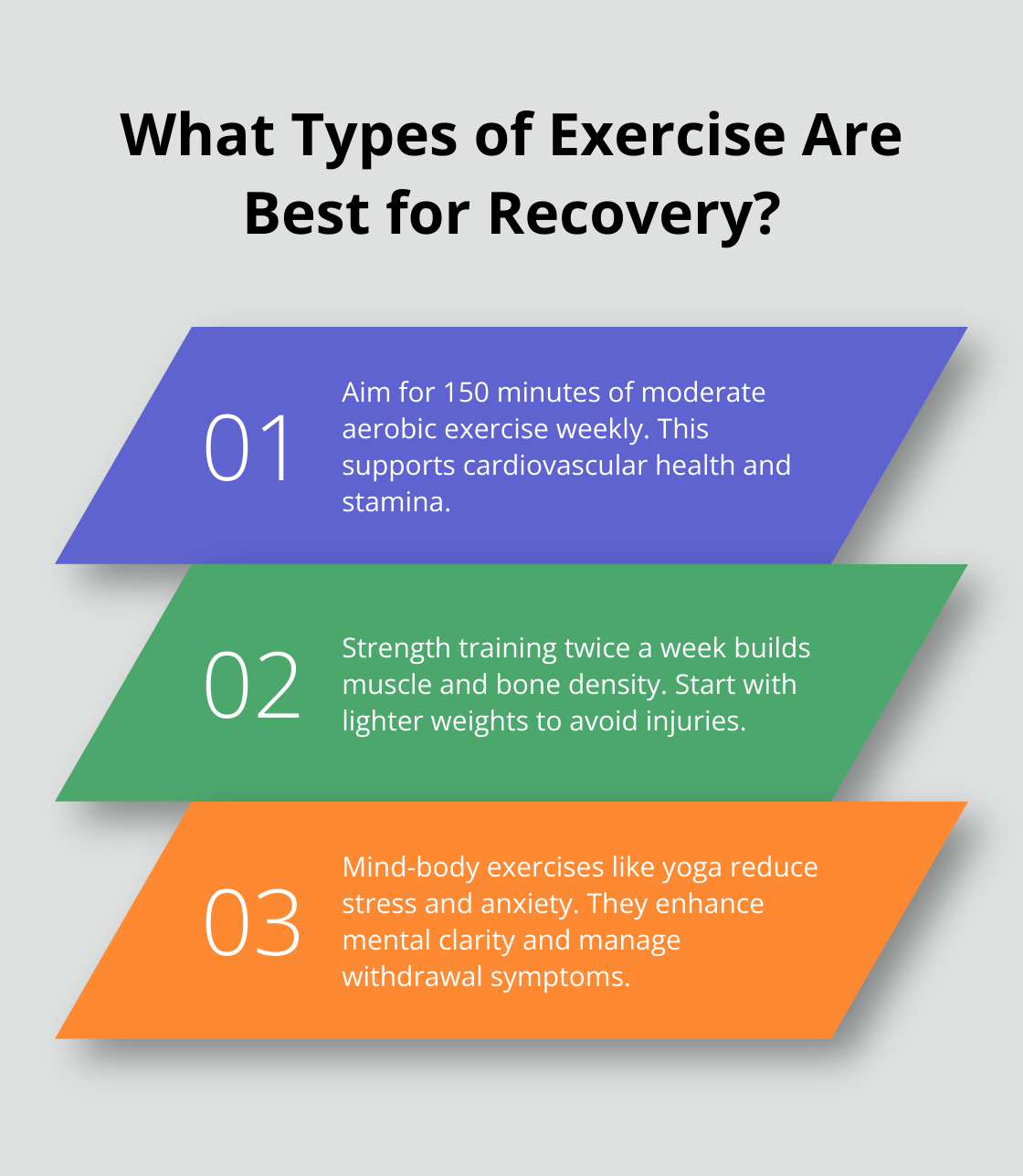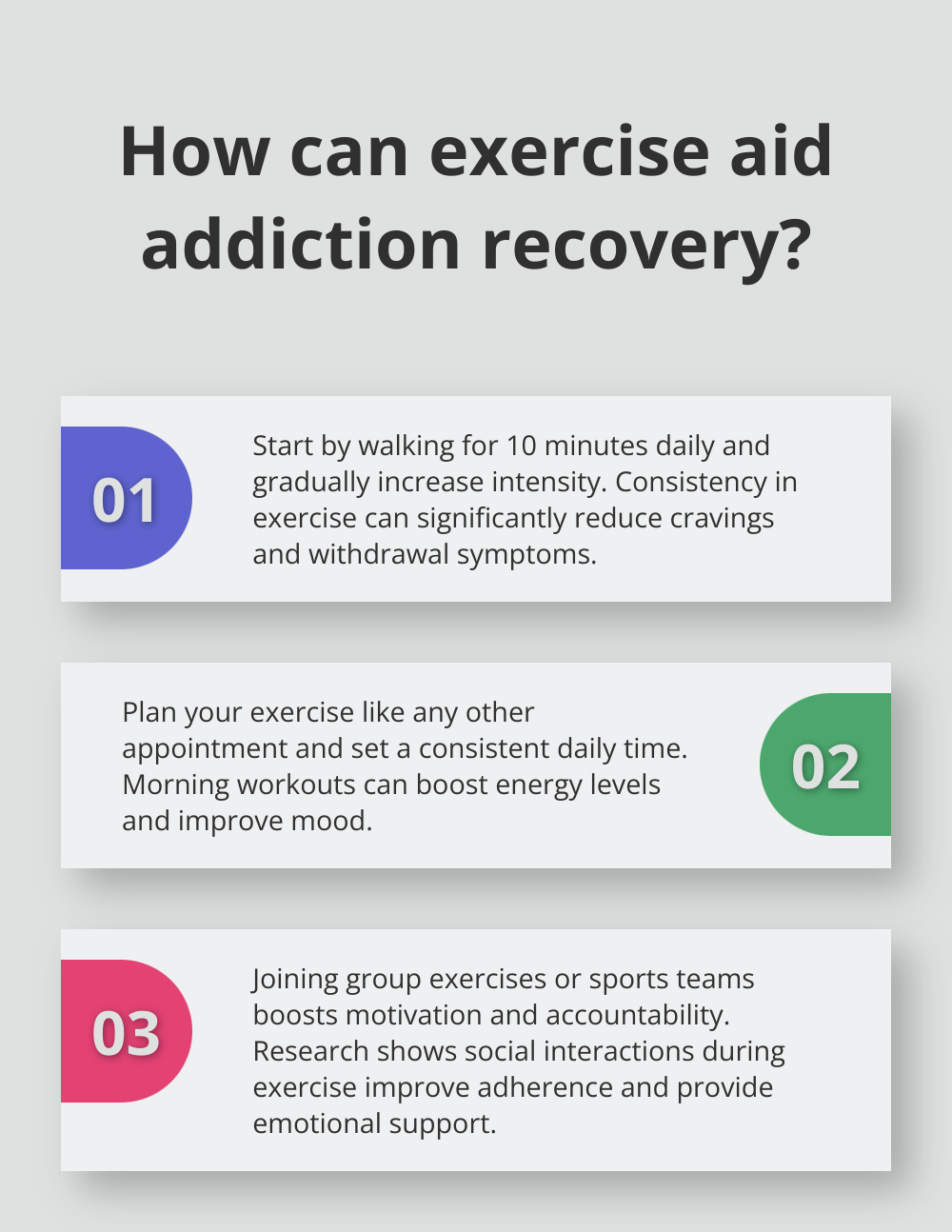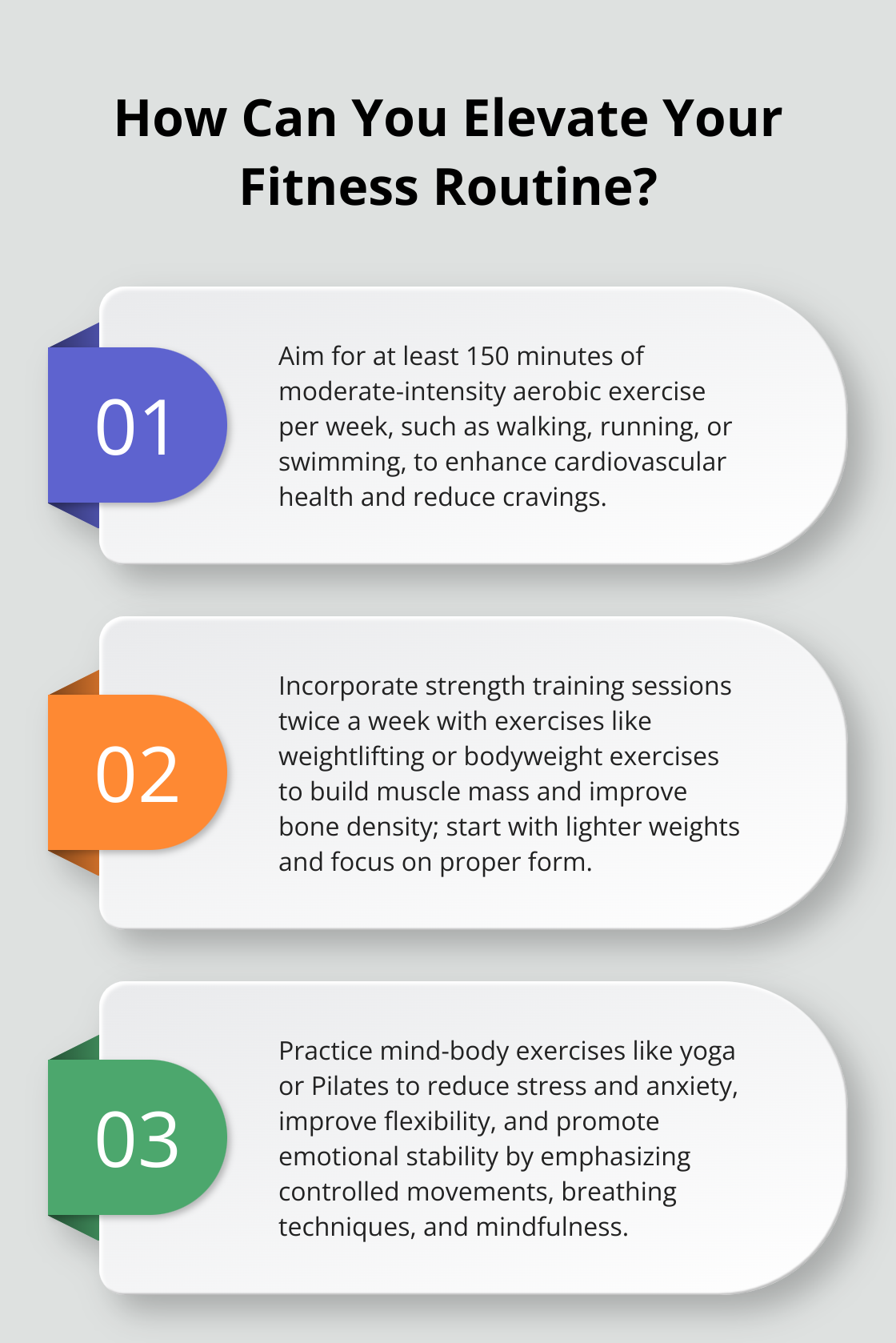Exercise can play a transformative role in addiction recovery. It boosts both physical and mental health, creating a solid foundation for long-lasting change.
At Ona Treatment Center, we emphasize the power of incorporating exercise into recovery plans.
Join us to explore the types of exercises that can support a healthier, more resilient life.
Why Is Exercise Important for Addiction Recovery?
Enhancing Physical Health
Engaging in regular exercise can be a game-changer for physical health during addiction recovery. Studies have shown that just 150 minutes of moderate-intensity exercise per week can significantly lower the risks of cardiovascular diseases, diabetes, and other chronic conditions which individuals recovering from addiction are often at higher risk for. Physical activity like walking, running, or swimming not only improves heart and lung function but also aids in weight management and strengthens bones and muscles.

In recovery, improved physical health can lead to better overall well-being. Exercise programs like aerobic and resistance training can enhance immune function and increase energy levels, making everyday tasks easier and more manageable. This can also help alleviate the physical side effects of withdrawal, such as general fatigue and muscle pain, creating a more comfortable recovery process.
Boosting Mental Health
The mental health benefits of exercise are profound. Aerobic exercises, for example, are associated with the release of endorphins, serotonin, and dopamine – neurotransmitters that contribute to the regulation of mood and emotions. These chemicals can replicate positive feelings, similar to those induced by addictive substances, thus reducing cravings and withdrawal symptoms.
Incorporating exercise into daily routines can help mitigate anxiety and depression, which are common among individuals in recovery. Regular physical activity has shown a 20-30% reduction in symptoms of depression and anxiety. Clearer thinking and better cognitive function are additional benefits, aiding in decision-making and promoting a positive outlook during the challenging times of recovery.
Establishing Healthy Routines
Building a consistent exercise routine is another critical component of addiction recovery. A well-structured routine can fill in the gaps of free time that may otherwise lead to risky behaviors or thoughts of relapse. Aiming for 30 minutes of exercise most days of the week can create a stable daily schedule, aligning with other recovery goals.
Exercise routines can also act as a positive outlet for stress. Activities like yoga and weightlifting provide not only physical benefits but also a mental focus, reducing the chances of falling back into old habits. Group exercise classes or joining recreational sports leagues can further support recovery by promoting social interaction in a healthy, substance-free environment. This sense of community and belonging can be a strong motivator and provide peer support, both essential elements for maintaining long-term sobriety.
Additionally, early incorporation of exercise into a recovery program can set the stage for lasting habits. By starting with manageable and enjoyable physical activities, and gradually increasing intensity, individuals can better integrate exercise into their daily life. Ultimately, the structured nature of an exercise routine provides a clear framework that can be crucial for sustaining recovery and establishing long-term wellness.
What Types of Exercise Are Best for Recovery?
Aerobic Exercises
Incorporating aerobic exercises into recovery routines is a practical and highly effective approach. Activities like walking, running, swimming, and cycling are excellent choices. Aiming for at least 150 minutes of moderate-intensity aerobic activity per week can significantly enhance cardiovascular health and improve lung function. This, in turn, supports overall stamina and energy levels, which are often depleted during substance use and withdrawal. Early research has shown that individuals who engage in regular aerobic exercise experience reduced cravings and lower relapse rates.
Strength Training
Strength training is another valuable component of a well-rounded recovery exercise plan. Engaging in resistance training exercises, such as weightlifting or bodyweight exercises like squats and push-ups, can build muscle mass, improve bone density, and enhance overall physical strength. Incorporating strength training sessions at least twice a week is recommended. For those new to strength training, starting with lighter weights and focusing on proper form is essential to prevent injuries. Consultation with a fitness professional can provide tailored guidance, ensuring exercises align with personal capabilities and growth.
Mind-Body Exercises
Mind-body exercises, including yoga and Pilates, offer unique benefits for individuals in recovery. These exercises emphasize controlled movements, breathing techniques, and mindfulness. Practicing yoga can reduce stress and anxiety, improve flexibility, and enhance overall mental clarity. It’s particularly beneficial in managing withdrawal symptoms and promoting emotional stability. Studies indicate that mind-body exercises can lower cortisol levels, a stress hormone often elevated during recovery.

Finding the right balance of these exercises can make a significant difference in the recovery journey. Combining aerobic activities, strength training, and mind-body exercises creates a comprehensive fitness routine that addresses various physical and mental health aspects.
How to Start Exercising in Recovery
Setting Realistic Goals
Establishing achievable goals can make the process of incorporating exercise into addiction recovery more manageable. Start with small, specific targets such as walking for 10 minutes every day. Gradually increase the duration and intensity as you become more comfortable. It’s important to recognize that pushing too hard, too soon can lead to burnout or injury, which can be counterproductive. Aim for consistency over intensity. Studies indicate that even short bouts of exercise can significantly reduce cravings and withdrawal symptoms.
Creating a Routine
A structured routine provides stability, an essential aspect of recovery. Plan your exercise as you would any other appointment. Set aside a consistent time each day dedicated to physical activity. Consider starting your day with exercise to boost energy levels and mood. Morning workouts can set a positive tone for the day and reduce the likelihood of skipping sessions due to unforeseen events. Mixing different activities, such as alternating between aerobic exercises and strength training, keeps the routine engaging and addresses various fitness needs.
Leveraging Support Systems
Building a support network can enhance motivation and accountability. Joining group exercise classes, recreational sports teams, or finding workout partners can make the experience more enjoyable. According to research, social interactions during exercise can boost adherence to fitness routines and provide emotional support. Being part of a community that encourages healthy habits can also reinforce your commitment to recovery. If possible, enlist the guidance of fitness professionals who understand the unique challenges of addiction recovery. They can tailor exercise programs to your specific needs, ensuring safety and effectiveness.

Conclusion
Incorporating exercise into addiction recovery holds numerous benefits. It enhances physical health by reducing the risk of chronic illnesses and aiding in weight management, while also boosting mental health through the release of mood-regulating neurotransmitters. Establishing a regular exercise routine can help create structure, which is essential for filling time that might otherwise lead to risky behaviors.

Taking the first steps can be as simple as setting realistic goals and creating a structured routine. Start with manageable activities like a 10-minute walk each day and gradually increase the duration and intensity. Leveraging support systems such as group exercise classes or finding a workout partner can enhance motivation and provide a sense of community.
The long-term impact of incorporating exercise into recovery can be profound. Regular physical activity can significantly reduce cravings and withdrawal symptoms, leading to lower relapse rates. Moreover, the mental clarity, improved mood, and better decision-making abilities fostered by exercise contribute to a more resilient recovery journey.
At Ona Treatment Center, we understand the transformative power of exercise in addiction recovery. Our evidence-based Living in Balance program, located in Northern California, offers personalized, holistic care that includes tailored treatment plans and life skills development. To learn more about how our comprehensive continuum of care can support your journey to a brighter future, visit Ona Treatment Center.






